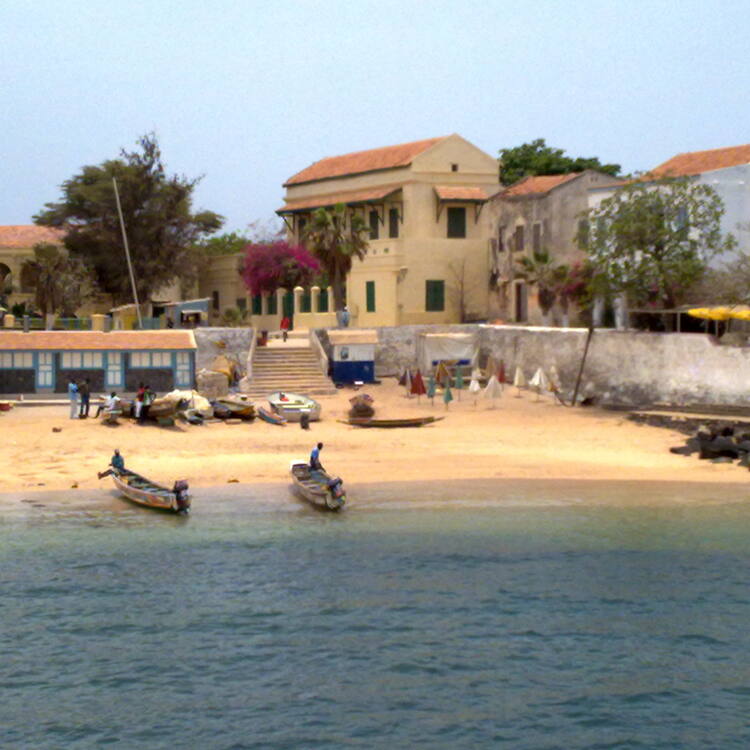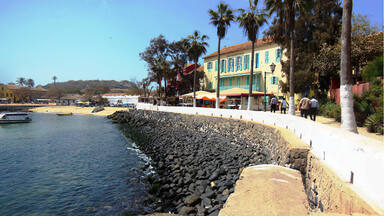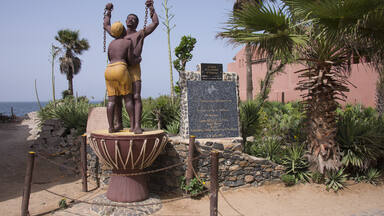Island of Gorée
Island of Gorée
The island of Gorée lies off the coast of Senegal, opposite Dakar. From the 15th to the 19th century, it was the largest slave-trading centre on the African coast. Ruled in succession by the Portuguese, Dutch, English and French, its architecture is characterized by the contrast between the grim slave-quarters and the elegant houses of the slave traders. Today it continues to serve as a reminder of human exploitation and as a sanctuary for reconciliation.
Description is available under license CC-BY-SA IGO 3.0
Île de Gorée
Au large des côtes du Sénégal, en face de Dakar, Gorée a été du XVe au XIXe siècle le plus grand centre de commerce d'esclaves de la côte africaine. Tour à tour sous domination portugaise, néerlandaise, anglaise et française, son architecture est caractérisée par le contraste entre les sombres quartiers des esclaves et les élégantes maisons des marchands d'esclaves. L'île de Gorée reste encore aujourd'hui un symbole de l'exploitation humaine et un sanctuaire pour la réconciliation.
Description is available under license CC-BY-SA IGO 3.0
جزيرة غوري
تمتد جزيرة غوري على عرض ساحل السنغال مقابل داكار، وقد شكلت من القرن الخامس عشر ولغاية القرن التاسع عشر المركز التجاري الأكبر لتجارة العبيد في الساحل الافريقي. وقد خضعت على التوالي لسيطرة البرتغال وهولندا وانكلترا وفرنسا، ما جعل هندستها تتميز بالتناقض بين أحياء العبيد المظلمة ومنازل تجار الرقيق الأنيقة. ولا تزال جزيرة غوري تجسّد حتى اليوم رمزاً للاستغلال البشري وموطناً للمصالحة.
source: UNESCO/CPE
Description is available under license CC-BY-SA IGO 3.0
戈雷岛
戈雷岛位于塞内加尔海岸不远处,与达喀尔隔海相望。从15世纪到19世纪,戈雷岛一直都是非洲海岸最大的奴隶贸易中心,历史上这里曾先后被葡萄牙人、荷兰人、英国人和法国人占领过。在戈雷岛上,既能看到奴隶住的简陋屋子,也能找到奴隶贸易商居住的优雅庭院,两类建筑物形成鲜明对比。今天的戈雷岛,依然能使人们记起那段人剥削人的历史,这里同时也是人们消除历史积怨、求得和解的神圣殿堂。
source: UNESCO/CPE
Description is available under license CC-BY-SA IGO 3.0
Остров Горе
Остров Горе расположен вблизи берега Сенегала, напротив Дакара. В XV-XIX вв. он был крупнейшим центром работорговли на африканском побережье, находясь под властью сменявших друг друга португальцев, голландцев, англичан и французов. Для его архитектуры характерен контраст между мрачными кварталами для рабов и элегантными домами работорговцев. Сегодня остров продолжает служить напоминанием об эксплуатации человека и, вместе с тем, - символом примирения.
source: UNESCO/CPE
Description is available under license CC-BY-SA IGO 3.0
Isla de Gorea
Situada en las aguas litorales del Senegal, frente a la ciudad de Dakar, la isla de Gorea fue el centro de comercio de esclavos más importante de las costas africanas entre los siglos XV y XIX. Estuvo sucesivamente bajo la dominación de portugueses, holandeses, ingleses y franceses. La adusta arquitectura de los barrios destinados a los esclavos contrasta con la de las elegantes mansiones de los mercaderes que vivían de su tráfico. Hoy en día, Gorea es un lugar de memoria de la explotación del hombre por el hombre y un santuario para la reconciliación.
source: UNESCO/CPE
Description is available under license CC-BY-SA IGO 3.0
ゴレ島
source: NFUAJ
Eiland van Gorée
Source: unesco.nl
Outstanding Universal Value
Brief synthesis
The Island of Gorée testifies to an unprecedented human experience in the history of humanity. Indeed, for the universal conscience, this “memory island” is the symbol of the slave trade with its cortege of suffering, tears and death.
The painful memories of the Atlantic slave trade are crystallized in this small island of 28 hectares lying 3.5 km off the coast from Dakar. Gorée owes its singular destiny to the extreme centrality of its geographical position between the North and the South, and to its excellent strategic position offering a safe haven for anchoring ships, hence the name “Good Rade”. Thus, since the 15th century it has been prized by various European nations that have successively used it as a stopover or slave market. First terminus of the “homeoducs” who drained the slaves from the hinterland, Gorée was at the centre of the rivalry between European nations for control of the slave trade. Until the abolition of the trade in the French colonies, the Island was a warehouse consisting of over a dozen slave houses. Amongst the tangible elements that reflect Gorée’s universal value are, notably, the Castle, a rocky plateau covered with fortifications which dominate the Island; the Relais de l’Espadon, former residence of the French governor; etc…
The Island of Gorée is now a pilgrimage destination for the African diaspora, a foyer for contact between the West and Africa, and a space for exchange and dialogue between cultures through the confrontation of ideals of reconciliation and forgiveness.
Criterion (vi): The Island of Goree is an exceptional testimony to one of the greatest tragedies in the history of human societies: the slave trade. The various elements of this “memory island” – fortresses, buildings, streets, squares, etc. – recount, each in its own way, the history of Gorée which, from the 15th to the 19th century, was the largest slave-trading centre of the African coast.
Integrity
The insular nature of Gorée and an arsenal of legal texts contribute to the physical integrity of the site. The Atlantic Ocean provides a natural buffer zone of nearly 4 km.
Authenticity
Listed as a historic site by the colonial administration in 1944, with specific safeguarding measures, Gorée has recorded no major construction since then that might adversely affect the authenticity of the site, the major components of which have remained almost intact. Moreover, the rehabilitations and restorations have been carried out essentially in accordance with the principles of the Convention.
Protection and management requirements
The Island of Goree was designated a historic site in 1944, with safeguarding measures in 1951 (under the colonial era). It was subsequently inscribed on the national heritage list in 1975 (Order No. 012771 of 17 November 1975) and on the World Heritage List in 1978.
In 1979, a Safeguarding Committee was created by Order, comprising all the stakeholders, to monitor compliance with the Convention (conformity of the rehabilitation works, security of the property, etc.). An Order for the appointment of a site manager has been drafted and is currently in the process of aoption.
The replica of the "Gorée Memorial" on the Castle is an eloquent example of what should be avoided when preserving the integrity of the site and, in agreement with UNESCO, a modification of this work will be undertaken.

 View photos from OUR PLACE the World Heritage collection
View photos from OUR PLACE the World Heritage collection

